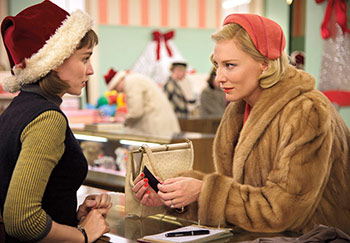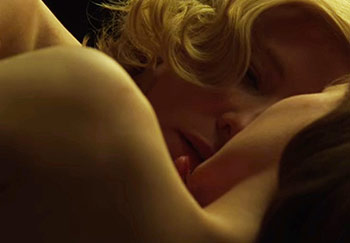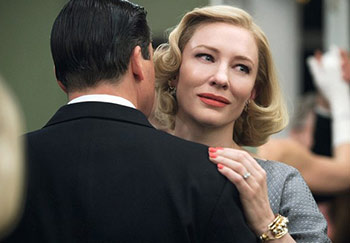follow us
Search this site
| contribute | advertise |
| terms of use |
© 2025 Mambaonline cc
| Lesbian South Africa |
| Lifestyle | News |

Lesbian film: Making Carol
07 January 2016

Carol is the acclaimed big screen adaptation of Patricia Highsmith’s seminal lesbian romance novel The Price of Salt.
A young woman in her 20s, Therese Belivet (Rooney Mara), is a clerk working in a Manhattan department store and dreaming of a more fulfilling life when she meets Carol (Cate Blanchett), an alluring woman trapped in a loveless, convenient marriage. As an immediate connection sparks between them, the innocence of their first encounter dims and their connection deepens.
While Carol breaks free from the confines of marriage, her husband begins to question her competence as a mother as her involvement with Therese and close relationship with her best friend Abby (Sarah Paulson) come to light.
As the post-World War II years ushered in many voices of change, crime author Patricia Highsmith wrote The Price of Salt, her second novel. Published in 1952, the sexual candour explored in Highsmith’s words made the book one of the seminal pieces of literature to come out of the era.
Emmy-nominated writer Phyllis Nagy adapted the screenplay from Highsmith’s original novel as director Todd Haynes brought the story of Carol to life for audiences today. Haynes was driven to recount Therese and Carol’s controversial relationship with a film that captured the social climate of the 1950s.
“Carol follows the unexpected love affair between two women of different ages and different social settings,” said Haynes. “A young woman in her early 20s, Therese, is embarking on life when she meets Carol Aird, an alluring older woman who has one daughter and is beginning to go through a divorce. As these two women become infatuated and entranced by each other, they begin to confront the conflicts their attraction provokes.”
Haynes wanted to draw on the aspect of unforeseen love as both Therese and Carol struggle to understand the signs and signals guiding their emotions.
“Carol is a love story that depicts how truth is the ultimate tonic. If you’re emotionally truthful to who you are and what you believe in, good things may not happen, but you will become a better person,” said writer Phyllis Nagy.
The law of attraction
For the role of the main character, Carol Aird, actress Cate Blanchett was struck by the emotional power of the story and how bold it was for the period it was written in.
Driven to play complex characters wrestling with secrets, Blanchett admits it is a “delicious thing to do” as an actress. “I think the gift of working on something based on a Patricia Highsmith novel is that the interior life of the characters is so rich— she’s masterful at dealing with characters who acknowledge, in a way, that every adult has a secret.”
 In portraying Carol in the film, Blanchett said, “Carol is someone who perhaps appears very remote and self-contained and self-possessed, but in a way I think she’s crumbling. She doesn’t fit— neither Carol nor Therese— fit neatly into a social circle or in that time, an underground movement. So I think they're both ambushed by the intensity of the connection they share with each other. It’s specifically about that other person rather than fitting into a larger group.”
In portraying Carol in the film, Blanchett said, “Carol is someone who perhaps appears very remote and self-contained and self-possessed, but in a way I think she’s crumbling. She doesn’t fit— neither Carol nor Therese— fit neatly into a social circle or in that time, an underground movement. So I think they're both ambushed by the intensity of the connection they share with each other. It’s specifically about that other person rather than fitting into a larger group.” As Carol recognises her feelings for Therese in the film, Blanchett points out the universal heartbreak that often comes with falling in love— “You risk being out of control and that is all part of the intoxicating thrill.”
To bring this emotion to the screen, Blanchett draws on the age difference between the two female characters and the greater threat Carol faces as the older woman. “If I fall headlong into this, I’m going to be falling in a different way than a girl who is much younger than me,” said Blanchett. “Therese is simply the product of her age and her own environment. There’s kind of a melancholy, wistfulness— a sense of a different apprehension that Therese just doesn’t have or understand.”
Carol’s husband Harge, played by Kyle Chandler, represents what is at stake as he challenges her in a custody battle over her daughter.
Sarah Paulson says of her character Abby, “she is part of the problem in Harge’s mind because he knows that Abby and Carol had a relationship once before. So partly, Harge is able to use that against Carol before he even knows what is actually going on between his wife and Therese.”
Paulson continues, “While Abby still has strong feelings for Carol, she does not reciprocate them. Carol loves Abby as her golden confidant and best friend, but is not romantically consumed with her as well. As Carol falls in love with Therese, Abby just has to sit back and watch it happen as it’s the only thing she can do.”
Carol and Therese’s relationship evolves to reveal a compelling love affair of the 50s, at a time when being lesbian was not culturally accepted. This interested Mara as she related, “When you’re falling in love, your mind kind of works the way a criminal’s mind would. You are constantly thinking about different scenarios and different things that could go wrong or different.”
In contrast to Carol, Mara brings Therese to audiences in a way that suggests her loneliness in the world. “Therese is not that grounded— she doesn’t have a home base and is in the middle of figuring out who she wants to be and what she wants her life to look like,” said Mara. “Carol really opens her world and her mind to what her life could be like, which helps Therese understand the kind of relationships she wants to have.”
Producers Elizabeth Karlsen, Stephen Woolley and Christine Vachon were confident in Patricia Highsmith’s universal message on love when they came together for the making of Carol. “I’ve always been interested in seeing films that feature strong female characters in dramatic storylines,” said producer Karlsen.

“Highsmith’s book was very daring when it was published, and in a way the story doesn’t feel as though it’s dated. Many aspects of what Carol and Therese endure are still relevant today.” Highsmith, however, was aware of her personal boldness as the writer of The Price of Salt when it was first published in 1952.
Now considered a masterpiece, the novel was initially released under the alias author of Claire Morgan— one of 40 pseudonyms invented by Highsmith throughout her career— due to its homosexual subject matter.
In completing production on the film, producer Stephen Woolley said, “Carol is very close to Patricia Highsmith’s novel and I think that’s an art in itself. It’s very difficult to take a book and write the script of that book in a way that comes to life on film for audiences. Carol enables audiences to experience The Price of Salt. And that’s an art — an invisible art that audiences can appreciate in our film.”
Every element of the story was re-imagined for the screen, painting a visually honest picture of society in the midst of change. Carol is a beautifully realised and impeccably acted piece of filmmaking.
Carol has already won a host of accolades for its director and cast, including the 2015 Queer Palm at Cannes and the New York Film Critics Circle Award for Best Film. It recently received nine British Academy Film Awards nominations and is also expected to do well at the Golden Globes and the Oscars.
Carol is now screening in selected cinemas in South Africa.


